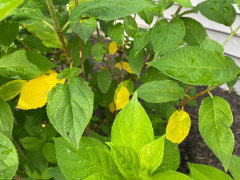The 2-Minute Rule for Hydrangea Leaves Turning Yellow
Hydrangea Leaves Turning Yellow - The Facts
Table of ContentsSome Known Details About Hydrangea Leaves Turning Yellow Hydrangea Leaves Turning Yellow for DummiesThe Basic Principles Of Hydrangea Leaves Turning Yellow Indicators on Hydrangea Leaves Turning Yellow You Need To KnowOur Hydrangea Leaves Turning Yellow Statements
The container needs to be big enough so the plant can grow and obtain all of the water and nutrients it needs. Panicles love the complete sunlight.Regardless of the range, plan in advance and make sure your plant has plenty of protection from the wind (Hydrangea Leaves Turning Yellow). You might transplant to a new place, or you could produce a wind barrier making use of one more plant, or fence.
Decorative yard, Rose of Sharon, or Holly shrubs are simply a couple of ideas of plants you can use to block the wind. If you need to transplant, locate a spot in your yard that is well secured from sunlight and wind. Hair transplanting is best done in the autumn or the spring.
The plants area is the most crucial aspect when it comes to getting established and proper development. With a little planning on growing place and correct upkeep, you'll be able to guarantee your hydrangeas!.
6 Easy Facts About Hydrangea Leaves Turning Yellow Shown

You can save the plant from yellow leaves by supplying it the appropriate light and positioning. If your plant obtains yellow fallen leaves, relocate to a dark area. Location Hydrangea plants inside near an east-facing home window. Dapple the plant with curtains or UV protection sheets to obstruct direct warmth.
, and temperature changes can cause yellowing leaves and brown areas. If it obtains too warm, the edges of the fallen leaves come to be yellow, turn brown and establish a crunchy appearance.

Hydrangea Leaves Turning Yellow Fundamentals Explained
However, yellow fallen leaves in Hydrangeas are the very first indicators of condition problem, often followed by black spots, browning, drops, and wilting. Separate the infected or pest-infested plant from the healthy and balanced plants to protect against condition spread. If it is a yard plant, eliminate all the infected leaves using like it sterilized tools and cleanse up all the particles.
Reducing off assists Hydrangea shade unnecessary weight and coverage, permitting the growth of brand-new fallen leaves. The very best time to prune Hydrangeas is spring when the plant prepares to grow foliage for the following season. Examine for spent or infected fallen leaves and cut the base of a stalk that joins the fallen leaves and stem.
Prevent cutting healthy and balanced or environment-friendly leaves, and do not remove greater than 25% of the plant's vegetation. Collect the discarded entrusts to shed or compost them. The main factor behind the red leaves other in Hydrangea is inadequate soil or environmental problems. If Hydrangea leaves have a white fine-grained compound on them, it implies Powdery Mold infection.
Likewise, repot the plant yearly in springtime or every 2 years if the growth price is slow.
More About Hydrangea Leaves Turning Yellow

There are 6 main reasons why this could occur:: The plant does not get adequate sunlight.: The roots are either too damp or as well dry.: The plant is also cold.: The dirt is not acidic or alkaline enough for the hydrangea.: The plant isn't obtaining the best nutrients it requires to stay healthy.
Each factor affects the plant in a method that can be dealt with if we comprehend just how to care for hydrangeas the best means. When we talk regarding poor light for hydrangeas, we imply that the plant isn't obtaining adequate sunlight.
Without sufficient sunlight, the fallen leaves can turn yellow, the plant can end up being weak, and it could produce fewer blossoms. To ensure a hydrangea gets appropriate light, it ought to be placed in a place where it can take pleasure in the early morning light and be protected from the intense mid-day sunlight. Overwatering is when a hydrangea plant obtains more important source water than it requires.
Without sufficient air, the origins can not do their job well, and the plant starts to experience. Yellow fallen leaves might be a sign that the plant is getting excessive water. On the various other hand, dehydration takes place when the plant does not obtain enough water. Like people, plants need water to stay healthy.
Getting The Hydrangea Leaves Turning Yellow To Work
This problem is common in the fall as the climate adjustments or if a hydrangea is grown in an area where it doesn't obtain adequate heat from the sun. It is very important to know the appropriate problems for hydrangeas to prevent low-temperature tension. The majority of hydrangeas grow best in areas 6 to 9, where the environment is milder.
It's essential to know that this kind of yellowing is different from the yellowing triggered by issues like way too much water or otherwise sufficient light. For that reason, if the yellow leaves are primarily at the bottom of the plant and the rest of the plant looks healthy and balanced, it could simply indicate that the leaves are merely getting old.